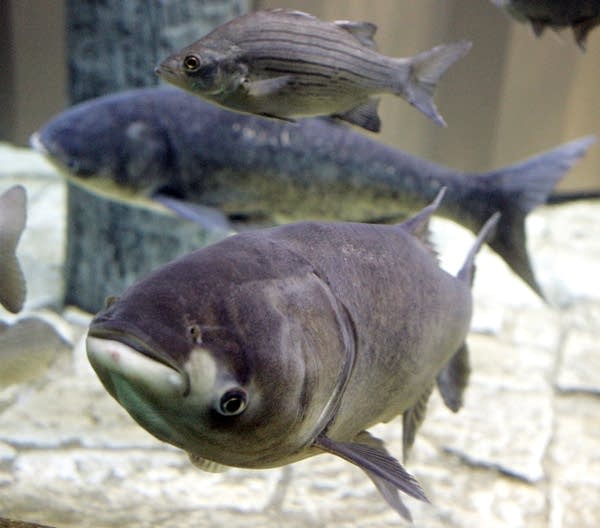Fight against Asian carp suffers new setbacks

Backers of an effort to keep destructive Asian carp out of the Great Lakes are pondering their next steps after suffering two setbacks Tuesday.
The U.S. Supreme Court refused to order the closing of shipping canals to barricade the voracious fish at the threshold of the Great Lakes, and a few hours later, officials reported the first indication the carp may be in Lake Michigan already.
Michigan, joined by Minnesota, New York, Ohio and Wisconsin and the Canadian province of Ontario, asked the high court to order the locks closed as a stopgap measure while considering a permanent separation between Lake Michigan and the Mississippi River basin.
The state of Illinois, backed by the Obama administration, fought the proposal. They said the DNA samples weren't sufficient evidence that the carp were on the verge of slipping into Lake Michigan, and said closing the locks would damage shipping and passenger traffic on the busy waterway.
Create a More Connected Minnesota
MPR News is your trusted resource for the news you need. With your support, MPR News brings accessible, courageous journalism and authentic conversation to everyone - free of paywalls and barriers. Your gift makes a difference.
Reaction was predictably sour in the upper Great Lakes states, with Minnesota Attorney General Lori Swanson saying she's disappointed, and that the carp, if established would become an economic and natural disaster.
John Sellek, a spokesman for Michigan Attorney General Mike Cox, said the court left open the possibility of taking up the merits of the case even though it declined to issue an order.
"Our case is still being heard to open the Chicago water diversion case, which would still be out bigger picture, path, to a solution that would satisfy all the Great Lakes states," Sellek said.
Closing the locks is intended to stop the progress of Asian carp, primarily bighead and silver carp, which have taken over rivers from the Gulf of Mexico to Minnesota. Scientists fear that if they reach the lakes, they could disrupt the food chain and endanger the $7 billion fishery.
The fish reproduce in incredible numbers; and out-eat native fish. Some grow up to 4 feet in length and weigh 100 pounds while consuming up to 40 percent of their body weight daily in plankton, the foundation of the Great Lakes food web.
They also have the dangerous habit of leaping out of water when startled by passing motor boats.
Michigan Gov. Jennifer Granholm said Tuesday that she and Wisconsin Gov. Jim Doyle are calling for an "immediate" summit at the White House with the Great Lakes governors to hammer out a solution. A subcommittee of the House Transportation Committee has announced a hearing on the issue February 9.
But the lawsuit could be moot if some new test results are borne out.
U.S. Army Corps of Engineers Major General John Peabody, said recent water samples containing carp DNA locate the invading fish across the Lake Michigan shore-line and technically in the big lake.
"One was taken from the south side of the breakwater in Calumet Harbor. That is part of Lake Michigan," Peabody said. "So, it's not past the breakwater, in open water, if you will, but it's above the shoreline."
A second positive DNA sample was taken nearby, in the Calumet River, about half a mile from the harbor.
Despite that, Peabody and other members of an Interagency Asian Carp Rapid Response Workgroup are not recommending closing shipping locks that connect badly-infested waterways with the Great Lakes.
For one, thing, Peabody said, they don't have that authority. But they also believe further testing and targeted controls like netting or fish poisons are appropriate.
And, the small numbers of positive samples don't mean the carp have taken hold, according to Cameron Davis, Senior Advisor to the Administrator with the U.S. Environmental Protection Agency.
"Even if a few live carp get into Lake Michigan, it does not necessarily mean that they have established self-sustaining populations," Davis said. "So our job at this point is to stay focused on suppressing those populations to the greatest extent possible."
The officials say the environmental DNA testing they're using is itself untested. While they give it a high level of confidence, the technology was rushed into use without the usual rigorous study for effectiveness.
"From a statistical standpoint, one or two positive eDNA hits would not be significant," said Charlie Wooley, Deputy Regional Director with the U.S. Fish and Wildlife Service. "I stress, not significant. Worrisome, absolutely, but from a population dynamic standpoint, not significant at this time."
Even though the developments are taking place hundreds of miles from Dick Martin's Siverson Fisheries in Superior, Wisconsin, he worries what the carp could do to a Lake Superior fishery that's been improving for decades.
"The herring numbers are way up. The trout are doing well, and you know, you'd hate to see that," Martin said. "The white fish on the south shore anyway, there's a good healthy population there, and anything that would affect that would be kind of disastrous for this industry here."
(The Associated Press contributed to this report.)
